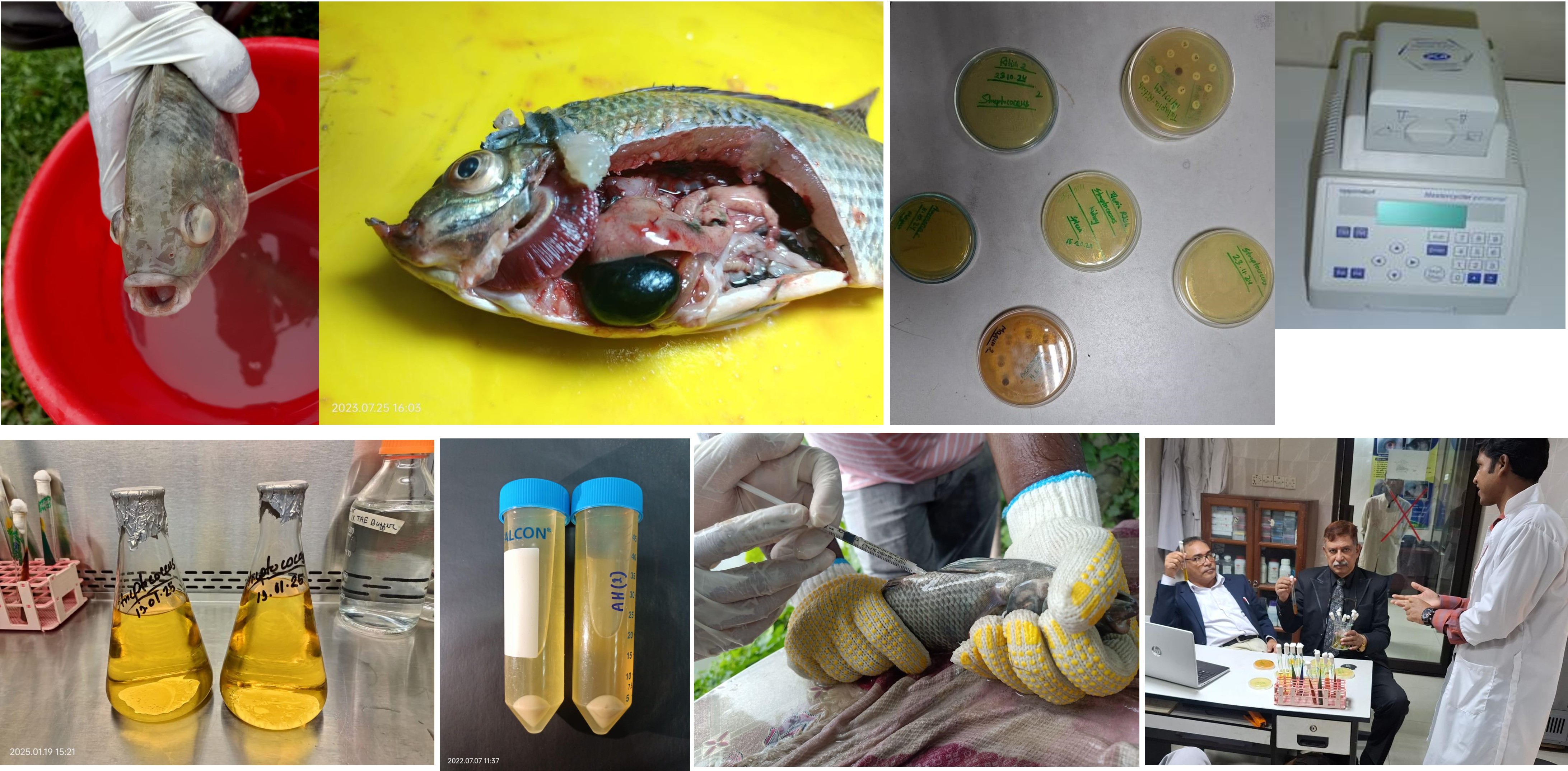Development of Tilapia Vaccine Against Infectious Diseases
Mymensingh
Among different cultured fishes, Tilapia has great potential, but unknown diseases are causing serious economic losses because of their mass mortality. To address the losses due to emerging diseases in Tilapia, antibiotics are the only option for farmers (Monir et al., 2020). Therefore, the aetiological agents of these fish diseases need to be identified and an effective preventive measure should be taken against these diseases to sustain the productivity of cultured Tilapia in Bangladesh. However, vaccination can be one of the most important and effective prophylactic techniques for preventing outbreaks of different infectious bacterial diseases in Tilapia aquaculture (Monir et al., 2019).
During the reporting period, 575 diseased tilapia were collected from 60 farms in Mymensingh, Gazipur, Cumilla, and Chattogram and processed at BFRI, Mymensingh. Bacteria were isolated, cultured on TSA and selective media, and characterized by morphology, Gram reaction, and biochemical tests and molecular methods. The PCR products were Sanger sequenced at First BASE Laboratories, Malaysia, and analyzed for homology using BLAST (NCBI, USA). An experiment on tilapia assessed bacterial pathogenicity using intraperitoneal (i.p.) injections, with 120 fish in aquaria, monitored for 14 days, and bacterial re-isolation performed post-mortem. The antibiotic susceptibility of Streptococcus sp. and Aeromonas sp. was assessed using the Kirby-Bauer disc diffusion method, following CLSI (2006) guidelines, and MAR index was also calculated.
Tilapia (Oreochromis sp.) were collected from 60 fish farms in Mymensingh, Gazipur, Cumilla and Chittagong districts whereas, the mortality recorded in the infected Tilapia farms was up to 60 to 80% within two weeks. Around 40% infected fish showed gross lesions that were associated with motile septicemia, including necrosis and haemorrhages in fins and tails (Figure 1a & 1b). Ocular haemorrhages accompanied by exophthalmia (uni- or bilateral exophthalmia) were observed some of the infected fish, alongside skin lesions on the body (Figure 1c & 1d). Upon dissection, the liver, spleen and kidney of the infected fish were enlarged with moderate to severe congestion. Additionally, haemorrhages in brain were also found most of the infected fish. Bacterial infections (73%) were the primary cause, followed by fungal (11%), parasitic (9%), and poor water quality (7%) issues. A total of 90 bacterial samples were isolated from 450 samples of diseased Tilapia. The sources of these strains are presented in Table 1. The isolation frequencies of these 90 strains upon anatomical parts of infected Tilapia were lesion (skin and fin) 11 (12.22%), liver/spleen 16 (17.78), head kidney 18 (20.00%) and brain/eyes 45 (50.00%) (Table 1). Most isolates were Gram-positive cocci in chains, positive for sucrose and mannitol, but negative for oxidase, VP, catalase, indole, H₂S, and urease tests. Streptococcus agalactiae and Aeromonas veronii were identified by BLAST analysis of 16S rRNA sequences (Figure 1). Streptococcus sp. infections peaked at 75% in July, with cumulative cases between April and October. Moreover, experimental infection with the isolated bacteria caused fish to show hemorrhagic septicemia symptoms similar to natural cases, with Streptococcus sp. causing 87% and Aeromonas sp. 67% mortality, confirming their role as primary pathogens. In addition, Streptococcus sp. showed 71.4% resistance and 14.3% susceptibility to the tested antibiotics, while Aeromonas sp. exhibited 57.1% resistance, 28.6% susceptibility, and 28.6% intermediate response under in-vitro conditions.
Tilapia farming in Bangladesh faces significant challenges due to the emergence of bacterial diseases, particularly those caused by Streptococcus sp. and Aeromonas sp. The study highlights the alarming mortality rates (60-80%) and the associated economic losses in infected farms. Comprehensive diagnostic analyses identified bacterial infections as the primary cause of these outbreaks, with Streptococcus sp. exhibiting alarming levels of antibiotic resistance. The findings underscore the urgent need for effective preventive measures, such as the development of vaccines and improved farm management practices, to mitigate the impact of these diseases and sustain Tilapia productivity in Bangladesh.
Isolated bacterial strains Distribution (Number & %) of different bacterial stains (n=90) according to site of isolation Total Anatomical parts of infected Tilapia Infected area (skin & fin) Liver/ Spleen Head kidney Brain/ Eyes Streptococcus sp. (SM-26) 1 (1.11) 0(0) 4(4.44) 9(10.00) 14(15.56) Streptococcus sp. (SC-27) 1(1.11) 3(3.33) 2(2.22) 11(12.22) 17(18.89) Streptococcus sp. (ST-22) 0(0) 0(0) 3(3.33) 9(10.00) 12(13.33) Streptococcus sp. (SC-21) 0(0) 2(2.22) 2(2.22) 8(8.89) 12(13.33) Streptococcus sp. (SG-28) 0(0) 1(1.11) 2(2.22) 8(8.89) 11(12.22) Aeromonas sp. (SM-21) 4(4.44) 5(5.56) 2(2.22) 0(0) 11(12.22) Aeromonas sp. (SC-22) 5(5.56) 5(5.56) 3(3.33) 0(0) 13(14.44) Total 11(12.22) 16(17.78) 18(20.00) 45(50.00) 90(100)


